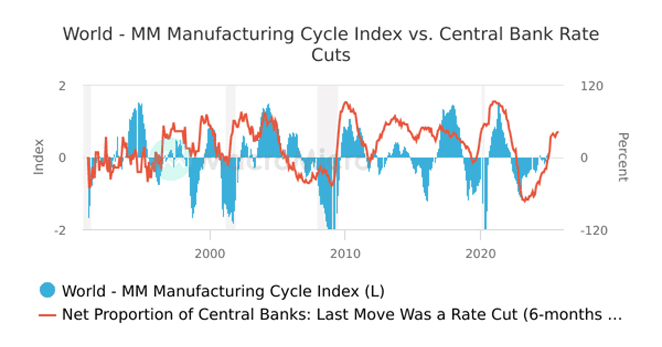
Global central banks will mostly stand ready for interest-rate cuts in the coming months to cushion their economies from US President Donald Trump’s trade war, most notably the disruptive effects of US President Donald Trump’s aggressive trade policies. As tariffs impact global supply chains, traders seek clarity in a market that thrives on predictability but is now affected by political volatility and inflation uncertainty.
This environment demands sharp attention and adaptive strategies. Understanding how global central banks navigate this rate-cut cycle is no longer just macroeconomic trivia: it’s a trading edge.
Why Rate Cuts Are Back on the Table

The central banks in advanced economies are adopting a more dovish stance amid a weakening global economy and rising US tariffs. Growth forecasts have been significantly reduced, global trade is contracting, and investor sentiment remains fragile.
- The World Trade Organization contemplates a drop in global commerce this year.
- The IMF is poised to lower its economic outlook.
- Expert analysts expect the average advanced-economy policy rate to decline by 50 basis points by year-end.
Despite lingering inflationary risks, monetary authorities are being pushed into action. The challenge? Finding the balance between stimulating growth and keeping inflation expectations in check.
Who’s Cutting, Who’s Cautious?

Global central banks are taking varied approaches to monetary policy as they balance inflation, growth, and market expectations.
Here’s how some of the key players are reacting and what traders should keep in mind.
- United States: The Federal Reserve currently holds its rate at 4.5%, with a forecast to reach 4.25% by the end of 2025. Markets have priced in three rate cuts, potentially beginning as early as June, but the Fed remains cautious. The key takeaway for traders is to monitor inflation and employment data closely. Unless economic indicators support aggressive easing, expectations may be premature.
- Eurozone: The European Central Bank (ECB) holds a current deposit rate of 2.25%, with a forecast drop to 1.75%. The market anticipates three rate cuts by the end of the year, with the first expected in June as inflation in the services sector begins to decline. If the European Central Bank (ECB) cuts rates too aggressively, it could lead to a rapid depreciation of the euro. Traders should also keep an eye on potential German fiscal stimulus and increases in defense spending, which could provide a buffer and possibly slow the ECB’s pace of easing.
- Japan: The Bank of Japan (BOJ) recently changed its position by raising its target interest rate to 0.5%, with an expected increase of 0.75%. However, the outlook remains uncertain. A potential rate hike in July is being considered, but political pressures and external factors, such as Trump’s stance on the yen, could complicate matters. Foreign exchange (FX) volatility and unexpected interventions may lead to sudden shifts in policy, making it essential for traders to remain agile.
- United Kingdom: The Bank of England (BOE) currently maintains a rate of 4.5%, with a forecast to reach 3.75%. The market has priced in three rate cuts, with the first expected as early as May. Though UK inflation remains sticky, upcoming tariff reductions are seen as disinflationary, setting the stage for a gradual easing cycle. A weakening pound may sway the BOE’s decisions, so traders should factor in GBP volatility when positioning.
- Canada: The Bank of Canada (BoC) holds a current rate of 2.75%, expected to decline to 2.30%. Markets anticipate two or more rate cuts as the year progresses. Given Canada’s strong linkage to global commodity markets, falling demand amid trade tensions may push the BoC toward a more dovish stance. Traders should closely watch commodity trends and trade headlines for clues to the central bank’s next move.
How Traders Can Stay Ahead

1. Track Forward Guidance Religiously
Central banks are doing more than ever to manage market expectations. Parsing central banker speeches and policy statements is crucial.
2. Watch Inflation vs. Growth Metrics
Central banks are caught in a tug-of-war. High inflation may delay cuts. Weak jobs or GDP growth may accelerate them. Align your trades accordingly.
3. Trade the Divergence
Not all central banks will move in sync. For example, if the Fed delays while the ECB cuts, USD strength versus EUR is a potential play.
4. Use Interest Rate Derivatives
Tools like swaps, futures, and options let you express your view on rate changes directly. Monitor swap spreads and OIS curves.
5. Stay Nimble
Market sentiment will shift rapidly as new data comes in. Flexibility is key whether you’re trading currencies, bonds, or equities.
The bottom line

The global financial landscape is undergoing a real-time stress test due to policy uncertainty, persistent inflation pressures, and escalating geopolitical trade tensions. Central banks are walking a tightrope, and those who can read the rhythm of their movements will be best positioned to capitalize.
The upcoming rate-cut cycle isn’t merely about monetary easing; it’s about strategic adaptation. In a market where central bank decisions are increasingly reactionary rather than forward-guided, the edge belongs to traders who blend macroeconomic foresight with sharp tactical execution. Agility, not assumption, will define success.







